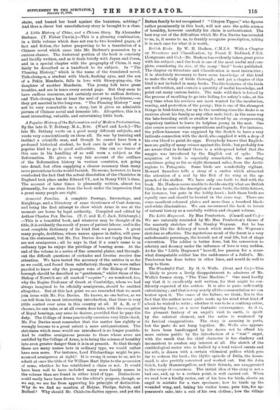British Birds. By W. H. Hudson, C.M.Z.S. With a Chapter
on Structure and Classification, by Frank E. Beddard, F.R.S. (Longmans and Co.)—Mr. Hudson has evidently taken great pains with his subject ; and the book is one of the most useful and com- plete, considering its size, of the many bird" books published. The chapter on Structure and Classification is most instructive ; it is absolutely necessary to have some knowledge of this kind to make the study of birds thorough ; and yet a chapter of this kind is not included in many books. The life-histories of the birds are well-written, and contain a quantity of useful knowledge, and point out many curious habits. The male wild-duck is forced by the process of moulting to go into hiding for safety's sake, at the very time when his services are most wanted for the incubation, rearing, and protection of the young ; this is one of the strangest things in bird-history, for up to the moulting-time the drake is as anxious about his family as any other male bird ; in the same way the late-breeding swift or swallow is forced by an overpowering migratory instinct to leave its helpless young in the nest. One also comes across curious superstitions and legends. For instance, the yellow-hammer was supposed by the Scotch to have a very intimate connection with the devil, who supplied it with a drop of his own blood to paint its eggs. Everybody knows that English- men are guilty of many crimes against the Irish ; but probably few are aware that in Ireland there is a widespread belief that the magpie was introduced by the English out of spite. The migration of birds is especially remarkable, the sandorling sometimes going as far as eight thousand miles, from the Arctic regions to Patagonia. Some birds are wonderfully vigilant. Howard Saunders tells a story of a curlew which attracted the attention of a seal by the flick of its wing at the ap- proach of the stalker. We have only one fault to find with the book. Mr. Hudson seems unable to decide exactly what are British birds, for he omits the description of some birds, the little bittern, for instance, but puts in the hobby-hawk ; both these birds are equally rare and should be treated in the same way. There are some excellent coloured plates and more than a hundred black- and-white illustrations. We can recommend the book to lovers of natural history as a carefully written and elegant volume.


















































 Previous page
Previous page